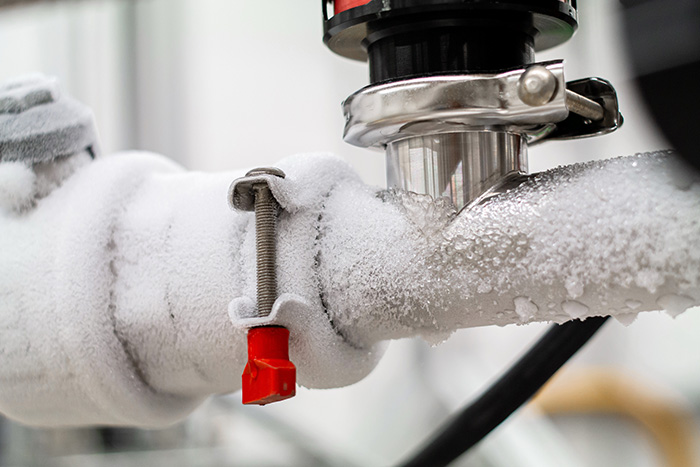How to Defend Your Pipes from Cold Weather: Expert Advice
How to Defend Your Pipes from Cold Weather: Expert Advice
Blog Article
We have uncovered this post about Preventing and dealing with frozen pipes directly below on the net and believe it made good sense to discuss it with you here.

Winter can wreak havoc on your plumbing, especially by freezing pipelines. Below's just how to prevent it from happening and what to do if it does.
Introduction
As temperatures decrease, the danger of frozen pipes increases, potentially resulting in expensive repair work and water damage. Understanding how to prevent icy pipes is important for property owners in cool environments.
Avoidance Tips
Insulating susceptible pipes
Wrap pipes in insulation sleeves or utilize warm tape to secure them from freezing temperature levels. Concentrate on pipelines in unheated or outside locations of the home.
Home heating strategies
Keep indoor rooms adequately heated, particularly locations with plumbing. Open cabinet doors to permit cozy air to flow around pipelines under sinks.
Just how to identify frozen pipes
Look for lowered water flow from taps, uncommon odors or sounds from pipes, and noticeable frost on revealed pipes.
Long-Term Solutions
Structural modifications
Take into consideration rerouting pipes away from exterior walls or unheated areas. Add additional insulation to attic rooms, cellars, and crawl spaces.
Updating insulation
Purchase high-grade insulation for pipelines, attic rooms, and wall surfaces. Correct insulation aids keep constant temperature levels and minimizes the danger of frozen pipes.
Shielding Exterior Pipes
Garden hoses and exterior taps
Detach and drain yard pipes before winter. Mount frost-proof spigots or cover outdoor taps with insulated caps.
Recognizing Frozen Pipelines
What triggers pipelines to freeze?
Pipes freeze when subjected to temperature levels listed below 32 ° F (0 ° C) for prolonged durations. As water inside the pipelines ices up, it expands, putting pressure on the pipe walls and possibly triggering them to break.
Risks and damages
Icy pipes can result in water system disruptions, residential or commercial property damage, and pricey fixings. Burst pipelines can flood homes and create substantial structural damage.
Indicators of Frozen Pipeline
Determining frozen pipelines early can avoid them from rupturing.
What to Do If Your Pipes Freeze
Immediate actions to take
If you think frozen pipelines, maintain taps available to ease pressure as the ice melts. Use a hairdryer or towels taken in warm water to thaw pipes gradually.
Verdict
Stopping frozen pipelines needs proactive actions and fast reactions. By recognizing the causes, signs, and safety nets, property owners can shield their plumbing throughout cold weather.
5 Ways to Prevent Frozen Pipes
Drain Outdoor Faucets and Disconnect Hoses
First, close the shut-off valve that controls the flow of water in the pipe to your outdoor faucet. Then, head outside to disconnect and drain your hose and open the outdoor faucet to allow the water to completely drain out of the line. Turn off the faucet when done. Finally, head back to the shut-off valve and drain the remaining water inside the pipe into a bucket or container. Additionally, if you have a home irrigation system, you should consider hiring an expert to clear the system of water each year.
Insulate Pipes
One of the best and most cost-effective methods for preventing frozen water pipes is to wrap your pipes with insulation. This is especially important for areas in your home that aren’t exposed to heat, such as an attic. We suggest using foam sleeves, which can typically be found at your local hardware store.
Keep Heat Running at 65
Your pipes are located inside your walls, and the temperature there is much colder than the rest of the house. To prevent your pipes from freezing, The Insurance Information Institute suggests that you keep your home heated to at least 65 degrees, even when traveling. You may want to invest in smart devices that can keep an eye on the temperature in your home while you’re away.
Leave Water Dripping
Moving water — even a small trickle — can prevent ice from forming inside your pipes. When freezing temps are imminent, start a drip of water from all faucets that serve exposed pipes. Leaving a few faucets running will also help relieve pressure inside the pipes and help prevent a rupture if the water inside freezes.
Open Cupboard Doors
Warm your kitchen and bathroom pipes by opening cupboards and vanities. You should also leave your interior doors ajar to help warm air circulate evenly throughout your home.

I discovered that article about How to Prevent Your Pipes From Freezing while exploring the search engines. Are you aware of another person who is excited by the niche? Do not hesitate to promote it. Many thanks for your time. Please visit our site back soon.
Book Appointment Report this page